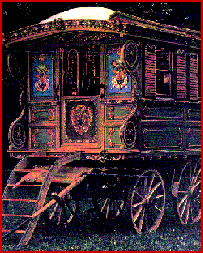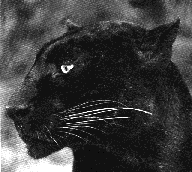
Human:
![]() Amari
Amari
![]() Essil
Essil
![]() Sena'kaneo'o
Sena'kaneo'o
![]() Zsidok
Zsidok
![]() Dytikos
Dytikos
![]() Kebites
Kebites
Other species:
![]() Ghjanoor
Ghjanoor
![]() Grug
Grug
![]() Pardos
Pardos
The Amari are a gypsy-like people who travel between the major cities of Waerlogas in large caravans. The Amari make their living as traders, entertainers, tinkers, rumormongers and (allegedly) petty thieves and as such have earned a reputation of moral flexibility. These reports are not entirely consistent, however; some stories paint them as an incredibly charitable folk, martyrs and champions of the dispossessed. It is generally agreed that the Amari are a suspicious lot whom trouble seems to chase.
 The people of Essenor are familiar with the Amari
custom of the Barishta Ralya, a great meeting of all the caravans that takes place in a
sheltered plain a few leagues from the city, once a year at midsummer.
The people of Essenor are familiar with the Amari
custom of the Barishta Ralya, a great meeting of all the caravans that takes place in a
sheltered plain a few leagues from the city, once a year at midsummer.
All the stories concerning the Amari exodus from their homeland paint their conquerors as
followers of the war god, Kharn. In the stories the people prayed and pleaded with the
other gods to intervene and stop the destruction of their homeland but were ignored. What
started as anger has simmered over hundreds of years into a bitter resentment that
manifests as sullen reluctance to even acknowledge the existence of conscious greater than
human powers. Thus, there are no Amari shamans, priests or sorcerers.
The Amari subscribe to a fatalistic set of beliefs called the Dol Madanya.
Looks
An average height of 5'9" for males and 5'7" for females.
Red-brown dark skin, glossy black or dark brown hair, and almost invariably black eyes.
Language and naming
Patterned after the real world language Swahili, Amari consists of lots of alternating consonants and vowels. The Trade Tongue is a derivative subset of Amari.
Here are some starter ideas for Amari names.
Essil
A creole culture (and language), Essil draws its
origins from the northern barbarians, Nuada Hlao, small villages along the Glissern, the Amari, refugees from the God Cities, and the strange precepts of the Ghjanoor.
Essil culture solidified with the Shifter takeover fifty years ago, to the point where those descended from the "original" Essiln view themselves as superior to the self-deluded foreigners who flock to the Free City.
To understand the typical Essiln, one must first understand how he views the Dreaming Magelords. A Shifter is a ruler, a philosopher, a hero, an ideal, a vision of human ascendency just this side of apotheosis. The typical Essiln family works hard for decades with the hope of sending just one of their children to the Monastos, to become an Aspirant. And perhaps, someday, a Shifter. The Shifters (whether intentionally or not) encourage this worship with a twice-annual festival held in the Silver District where they demonstrate their formidable powers for show.
Grugs are there to serve, says the Essiln. Grugs will not give themselves names, so those who order them about typically give them numbers. An Essiln would never consider enslaving another human, but the grugs aren't human.
The Ghjanoor are also not human, but their job seems to be to protect, a profession they pursue within the Utor-Ka. Essiln have nothing but respect (and some fear) for the Utor-Ka, whatever color their skin.
Looks
Average height is 6'2" for men, 6' for women.
Pale and willowy, dark hair, variable-colored eyes.
Language and naming
A creole language superficially like Amari but with an amazing preponderance of r's, l's and n's.
Sena'kaneo'o
Often referred to as the Northern Barbarians, the primitive tribes of the forested steppes have one of the oldest cultures around. They are known for their shapechanging ability and affinity with certain of the animals. Here is the myth passed on that tells why:
The seventeen totem spirits were confused when the first men came to their forest from the house of the sun and moon. How, they wondered, could such weak, furless, toothless creatures survive, especially since they did not even have a totem spirit in the spirit circle? They saw a man with a stone knife and decided that men must be clever, like Matseskome, and so they gave men a place in the circle between clever Matseskome and fierce Ma'hahko'e. The strong, flesh-eating spirits hunted men, and the meek, plant-eating spirits hid from them.
Time passed, and the fire flower blossomed in the stone circle. The spirits had to look again to the place of men, for fierce Ma'hahko'e hunted at night and would not go to the dens of men when the fire flower grew among the stones. Great Nahkohe was angry that men would abandon their seat in the spirit circle, and rumbled that he should move among them to kill rather than hunt. But clever Matseskome had learned to fill it's pouches with the seeds men scattered on the hillsides, and counseled instead that the seat of man should only be moved to lie between fierce Ma'hahko'e and patient Ho'nehe Mahpe. The totem spirits knew Matseskome to be clever, so they agreed and man's seat in the circle was moved.
Time passed, and the spirits were roused again to a terrible roaring from great Nahkohe, who suffered a burning pain in his ponderous backside. "Matseskome!" thundered the spirit, awful in his rage, "Look where your wisdom has led us! The men have learned to sting like tiny Hahnoma!" Furious, he pulled the feathered wooden shaft of an arrow from his rump. "Now I will move among the men to kill and not to hunt, because you will say that they should move to my right in the circle and it will not be so."
Many voices spoke to move the place of men between great Nahkohe and Okohke the Gore Eater. Whining Oeskeso had become like a servant to men and did not want to survive without their scraps and safe walls. Feathered Ve'keso begged that men be saved, for she loved to eat the hard fruits of their fields. But Great Nahkohe would not be swayed and none were strong enough to oppose him, so with fanged Peho'xa at his side he swept furiously from the forest and into the village of men.
Nahkohe and Peho'xa moved among men to kill instead of hunt for an entire dance of the moon. So many died that the moon wept bloody tears at the fate of her children, and the sun grew pale and barely burned to greet them with the new day. But while his brothers and sisters died, Dreaming Red Dreams and all the shamans of all the tribes lay buried deep in their lodges, guarded by the strongest warriors as they wove a great dream net. When the moon had completed her first dance since the time of killing, the shamans floated up from their lodges and cast their dream net down on Nahkohe and Peho'xa, binding them fast.
Dreaming Red Dreams knew that the net would not hold great Nahkohe and fanged Peho'xa for long, but he was clever. He took the net in one hand and placed the other behind his back, then went to stand before the spirit circle. He said,"Men are the children of the sun and moon, and do not belong in the spirit circle. Instead, you will make children with the shamans of the seventeen tribes, and then you will be our totem spirits. If you do not, I will stab Peho'xa and Nahkohe with my dream knife, and then catch you in my net and stab you until man is the only one in the circle. But if you do, our children will not hurt you, because your blood will flow in their hearts."
The spirits were afraid, because Dreaming Red Dreams and his net were terrible to behold, and they remembered the stone knives of men. So they agreed and cast the bargain in blood and saliva, and made children with the shamans — children with purple irises. That is why the folk only move among the beasts to hunt, and never kill, and why we have the gifts of the totem spirits.
Looks
Average height is 5'10" for men, 5'9" for women.
Olive to yellow complexion, straight dark hair, eyelids with an epicanthic fold, eyes ranging from gray to purple.
Language and naming
Their language is based on the Native American speech of the Cheyenne.
Here are some ideas for how names are structured. Here is some more vocabulary, just in cae you want it.
Zsidok
Looks
Average height is 6' for men, 5'10" for women.
Pale white skin, light brown or blonde hair, universally blue eyes and long fingers.
Language and naming
Based on Hungarian, here are some examples of names in that tortuous language.
Dytikos
Looks
Average height 5'6" for men, 5'4" for women.
Stout build, very dark brown skin, frizzy black hair, and honey-brown, dark brown or hazel eyes.
Language and naming
Their language is basically a pseudo-Greek one.
Here are some ideas for names.
![]()
Once the Boiling Ocean to the far west was called by another name, the name of its god: Keba.
Along the shores of Keba the Giver stood the city of Kebato. Then came the Day of Loss: Kebato was destroyed, Keba was lost to his worshippers, and the primitives living within Kebato were doomed to wander the West as nomads.
Most remaining Kebites dwell in the slums of free city Catan; others returned to the
wastelands. The clan is, for all intensive purposes, extinct.
Ghjanoor

Green, bug-eyed, toad-like humanoids.
They live where humans live, although the race is supposed to have originated in the swamps north of Essenor and they often return there for short periods of time.
Associated with the Utor-Ka, most work in
the larger free cities as guards and warriors-for-hire.
They are strong willed, remarkably (surprisingly) agile. Renowned for their
courage, they are both honorable and loyal, as a rule.
They seem quite content filling their roles
in the warrior caste.
And enjoying their nottle.
Grug

Five-foot tall, long-armed, apelike humanoids.
They function in Essenor as slaves and servants, with required obedience to all humans.
Their export is forbidden by law.
They sleep in underground basements beneath the topless towers.
They have no names among themselves, but are given numbers by their taskmasters, which they accept silently.
The Shifters enslaved them, when the Dreaming Magelords took over Essenor. Before that, the grugs dwelled in Essenor peacefully. It is obvious that the grugs did not build the city.
The grugs have never tried to rebel.
Most non-Essiln pity them.
Pardos

Tawny-coated, man-sized great cats.
They dwell in various savannah and forested areas to the far west and north.
They live by hunting and so do not often travel into agricultural or urban locales.
Pardos have a great ability to work together combined with deadly individual prowess.
However, they are primitive: no crafts, no written language, no tools.
The only human contact they have is with the Northern Barbarians.